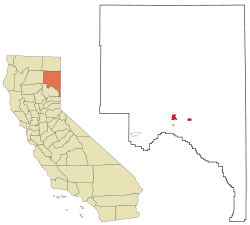High Desert State Prison (California)
High Desert State Prison (HDSP) is a high-security state prison that houses level IV inmates located in Susanville, Lassen County, California.[2][3] Opened in 1995, it has a capacity of 2,324 persons.
 Aerial View | |
%26groups%3D_c9c24917bf5ea0a9d26fa62bba59e1a45520fc91.svg)
| |
| Location | Susanville, California |
|---|---|
| Coordinates | 40.4084°N 120.5139°W |
| Status | Operational |
| Security class | Maximum-Supermax |
| Capacity | 2,324 |
| Population | 3,286 (141.4% capacity) (as of April 30, 2020[1]) |
| Opened | August 1995 |
| Managed by | California Department of Corrections and Rehabilitation |
| Warden | Fred Foulk |
As of April 30, 2020, High Desert was incarcerating people at 141.4% of its design capacity, with 3,286 occupants.[1]
Also located in Susanville is the state California Correctional Center, a minimum-security prison. A third prison facility, the Federal Correctional Institution, Herlong, is also located within Lassen County, California. Half the adult population of Susanville works at these prisons. The prisons and their effects on the community, including as a source of much needed jobs, were explored in the documentary, Prison Town, USA (2007), aired on PBS.[4]
Investigation

In late 2015 the state Office of the Inspector General completed a six-month investigation into conditions at the prison, after complaints of officer misconduct and prisoner abuse, and issued its report, calling for changes at the facility. Although there are buildings to house certain inmates in protective custody, such as sex offenders, officers put other prisoners near them. The inmates are mostly minorities and complained about discriminatory treatment, as well as officers allowing drug sales and violent retaliation; the officers are mostly white. The prison has had a rapid turnover in top management for nearly a decade, with seven wardens in eight years. In their report investigators wrote there was a "perception of insularity and indifference to inmates" at High Desert, exacerbated by its remoteness and "a labor organization that opposes oversight to the point of actively discouraging members from coming forward with information that could … adversely affect another officer."[5]
Notable inmates
- Terry Peder Rasmussen, serial killer, died in the prison in 2010
- Joe Son, former MMA fighter and convicted rapist
References
- "California Department of Corrections and Rehabilitation: Monthly Report of Population As of Midnight April 30, 2020" (PDF). California Department of Corrections and Rehabilitation, Division of Internal Oversight and Research. April 30, 2020. Archived from the original (PDF) on May 2, 2020. Retrieved May 2, 2020.
- "Susanville city, California Archived 2012-10-20 at Archive.today." U.S. Census Bureau. Retrieved on September 25, 2011.
- "High Desert State Prison." California Department of Corrections. Retrieved on September 25, 2011. "475-750 Rice Canyon Rd. Susanville, CA"
- "Prison Town, USA". Making Contact. Season 11. Episode 31. 2008-07-30. External link in
|title=(help) - "State investigators cite culture of abuse, racism by High Desert State Prison guards", Paige St. John, LA Times, 16 December 2015; accessed 26 June 2016
External links
- California Department of Corrections and Rehabilitation Official website
- Special Review: High Desert State Prison/ Susanville, CA, at Prison Legal News, December 2015, full text of Office of the Inspector General report online